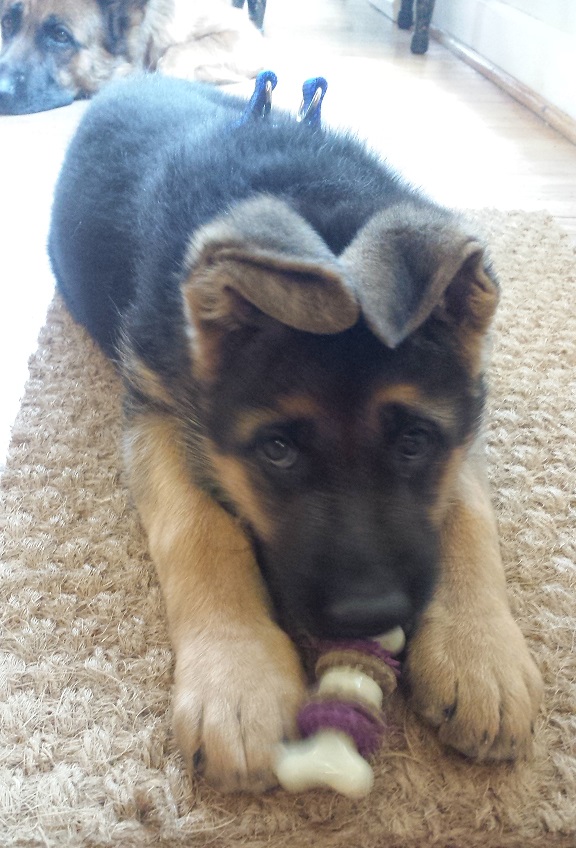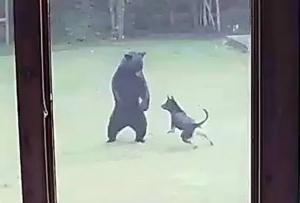 German Shepherds, as a general rule, are quite intelligent. Logically speaking, it makes sense. As a herding breed, shepherds have to be cognitively capable of problem solving to some extent in order to determine how to move all their wooly charges where they need to be. Unfortunately for us, most people who own German shepherds do not also own sheep! When you take an intelligent and driven dog’s job away, they tend to create other ways to keep themselves entertained… this is when your couch cushions tend to suffer the most. Dogs do chew while teething, but most chewing occurs because a dog is simply bored.
German Shepherds, as a general rule, are quite intelligent. Logically speaking, it makes sense. As a herding breed, shepherds have to be cognitively capable of problem solving to some extent in order to determine how to move all their wooly charges where they need to be. Unfortunately for us, most people who own German shepherds do not also own sheep! When you take an intelligent and driven dog’s job away, they tend to create other ways to keep themselves entertained… this is when your couch cushions tend to suffer the most. Dogs do chew while teething, but most chewing occurs because a dog is simply bored.
Why Dogs Chew
Our dogs all have the genetic code to hunt and kill prey, yes, even the tiny teacup Chihuahua believes he can catch that rabbit twice his size. Thousands of years of evolution does not simply disappear because we bred Sparky to be 2 lbs. and live in our house. Unless a trait makes an animal less likely to survive, it’s not going anywhere. Because our dogs survived by using their predatory drive to catch food, that drive still lingers to this day.
To catch a rabbit, Sparky has to sniff around and find a trail, stalk his prey, chase, grab, rip apart, and chew up the pieces. Every dog has the genetic code to perform those steps, and even if they are not forced to catch their own food to survive your pet still enjoys doing those behaviors. A dog that enjoys playing fetch is exercising his need to chase and grab, while a dog ripping apart your couch cushion and chewing on the remnants is expressing his need to dissect and gnaw a “catch”.
So What Do I Do to Stop it?
Address the source of the behavior. If your dog is chewing or showing any other types of destruction it is important to ensure they are getting enough mental stimulation. Earlier we discussed how our dogs can suffer when they no longer have a “job”… let’s give them one! Make sure your pet has plenty of opportunities throughout the day to use their brain, whether it’s training sessions or chew toys your pup should be receiving ample amounts of stimulating activity. There are a number of different chews that may help your dog alleviate some of that need to gnaw on something.
Bully Sticks
Our primary choice should be bully sticks given in moderation. Because bully sticks are capable of being gnawed on for extensive periods of time, and they are fully digestible (so your pet can chew them up and eat them), your dog will tackle some of that basic instinct to bite.
Deer Antlers
Another chew many dogs enjoy are deer antlers, specifically those split in half or “filet” as they are slightly softer on the inside. Many dogs will spend upwards of 20 minutes worrying a deer antler, and all of that time spent chewing is stimulating your dog’s natural instincts. These are not intended for complete consumption, so if your dog breaks off chunks remove the antler pieces as they could present a choking hazard.
Kong Toy
Another type of work-to-eat toy that is mentally stimulating for dogs is the classic KONG toy, when used properly. They are typically sold with a chewable “stick” or a cookie shaped like a smaller version of the toy, neither of these are ideal for keeping your dog preoccupied for an extended period. Instead, fill your KONG with a mixture of pumpkin and peanut butter, and then freeze. Because the mixture is frozen it will take longer for your pup to eat, and when it melts the pumpkin keeps its texture without getting watery and making a mess. If your dog isn’t interested try adding a little more peanut butter to the mixture, and globbing some around the edge of the opening so they can get to it with less effort.
Why Not Just Use the Good Ol’ Rolled Newspaper?
Many dog trainers and pet owners still use punishment to correct behaviors that they don’t like, this can be detrimental to your bond with your dog and can also cause extreme behavioral complications in the long run. Lets use our teacup Chihuahua as an example again: if Sparky has stolen a dish rag and is chewing it when I get home, and I snatch it from him and spank him with it, there are a few different behaviors that could follow. Sparky could immediately aggress towards me, because I have activated his fight or flight instinct.
Alternatively, Sparky could cower in fear, and my bond with him could potentially be damaged. Though he may not cower in fear for the rest of his life, Sparky may always show a fear of soft toys with a texture similar to that of the dishtowel, or may become fearful every time I am near the dishtowel while doing dishes or cooking. This is causing undue fear and punishment when Sparky has done nothing wrong.
Another common reaction to this type of “solution” could be the development of resource guarding. Sparky becomes accustomed to me angrily snatching away the dishtowel, and begins snarling anytime I come near him when he has a toy expecting the same results as the dishtowel. Punishment of even “simple” things can cause much more complicated associations than you may anticipate, and punishment has been shown to be much less effective in dog training because of this. I used Sparky as an example because a 2 lb. teacup Chihuahua will still bite you, but he is not nearly as scary as an 80 lb. German Shepherd. Though they have been domesticated, anything with teeth can bite, and when you are working with a large and potentially dangerous animal it is important to make sure that you are giving that animal proper feedback and avoiding creating dangerous behavior patterns. Why punish a behavior when the results will most likely create more problems and not even aid in a solution?
Empathize with your dog, they are intelligent animals that need lots of mental stimulation to live an enriched life, and if we are not providing well enough for them they will seek it elsewhere. Rather than blaming your dog, ask yourself if you are doing enough to keep them satisfied. If you aren’t doing enough, start doing more to help them alleviate their natural need to chew and play. By preventing the problem from occurring in the first place, and giving them safe and effective alternatives, your pup will be on the road to success in no time.




